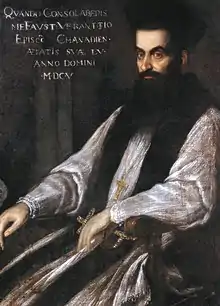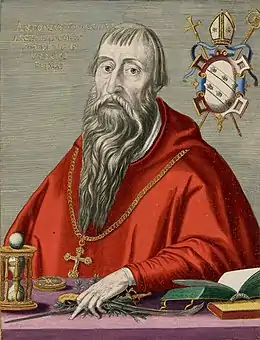Fausto Veranzio
Fausto Veranzio[1] (croate : Faust Vrančić[2]; latin : Faustus Verantius; hongrois et latin vernaculaire: Verancsics Faustus)[3] - [4] (Sebenico[5], République de Venise, vers 1551 – Venise, ) est un polymathe et un évêque de la République de Venise[6].

| Naissance |
c. 1551 Sebenico ( |
|---|---|
| Décès |
) Venise ( |
| Nationalité | Vénitien |
| Résidence | Sebenico, Venise, Prague, Padoue |
| Domaines | Sciences, Ingénieur, Lexicographie, Philosophie |
|---|---|
| Institutions | Université de Padoue |
| Renommé pour | Inventeur du parachute |
Biographie
Histoire familiale

Fausto nait à Sebenico[5], à l'époque dans la République de Venise[7], dans la famille des comtes Veranzio (qui devient plus tard la famille Draganich, les comtes Draganich-Veranzio)[8], une famille d'écrivains.
Il est le fils de Michele Veranzio, un poète latin, et le neveu d'Antonio Veranzio (croate : Antun Vrančić)[8], Archevêque d'Esztergom (1504–1573), un diplomate, relation d'Érasme (1465–1536), de Philippe Mélanchthon (1497–1560) et de Nikola Šubić Zrinski (1508–1566). Il emmène Fausto avec lui lors de ses voyages en Hongrie et en République de Venise[9].
La mère de Fausto est de la maison Berislavić. Son frère, Giovanni, meurt jeune au combat[8].
Éducation et activité politique
Veranzio est intéressé dans sa jeunesse par la science. Enfant, il déménage à Venise pour y faire sa scolarité puis à Padoue pour rejoindre l'université où il étudie le droit, la physique, l'ingénierie et la mécanique.
À la cour de Rudolf II dans le château de Hradčany à Prague, Veranzio est le chancelier de la Hongrie et de la Transylvanie. Il est souvent en contact avec Johannes Kepler et Tycho Brahe.
Après la mort de sa femme[10], Veranzio quitte la Hongrie. Il reçoit en 1598 le titre d'Episcŏpus Csanadiensis[11] in partibus. En 1609, de retour à Venise, il rejoint l'ordre des Barnabites et se consacre à l'étude des sciences.
Veranzio meurt en 1617 à Venise et est enterré en Dalmatie près de la maison de campagne de la famille, sur l'île de Prvić, dans la mer Adriatique.
Polymathe et inventeur
L'œuvre la plus importante de Veranzio, Machinae Novae (Venise, 1595), contient 49 planches décrivant 56 machines, des outils et des concepts techniques. Deux versions existent, une avec le Declaratio en latin et en italien, l'autre en trois autres langues. Seules quelques copies ont survécu et aucune n'a le texte complet dans les cinq langues. Le livre est écrit en italien, en espagnol, en français et en allemand[12]. Veranzio écrit sur l'eau, sur l'énergie solaire, sur l'horloge universelle (Planches 6–7), sur différents types de moulin, sur des machines agricoles, sur différents types de ponts construits avec différents matériaux, sur des machines pour nettoyer la mer, sur différents types de voitures, sur l'Homo Volans (planche 38) un ancêtre du parachute. Il est à l'origine de l'idée de l'utilisation de presses rotatives (planche 40).
Malgré la rareté de ses livres (Veranzio publie à ses frais et arrête la publication par manque de fonds)[12], le Machinae Novae est l'œuvre qui fait connaitre Veranzio. Ces dessins sont même réimprimés quelques années plus tard et publiés en Chine[13].
Notes et références
- (en) Cet article est partiellement ou en totalité issu de l’article de Wikipédia en anglais intitulé « Fausto Veranzio » (voir la liste des auteurs).
- Alfred Day Rathbone, He's in the paratroops now, R.M. McBride & Company, 1943, University of California. page 172
- prononcé originellement "vranchich"
- Andrew L. Simon, Made in Hungary: Hungarian contributions to universal culture
- The Hungarian Quarterly, Vol. XLII * No. 162 *, Summer 2001 László Sipka: Innovators and Innovations
- Aujourd'hui Šibenik, en Croatie. Cfr. A collection of modern and contemporary voyages & travels, Oxford University, 1805
- Berthold Laufer, The Prehistory of Aviation Chicago Field Museum of Natural History, University of Michigan, 1928
- (en) John Crerar and Anthea Library and Waleson, Nature disclosed : books from the collections of the John Crerar library illustrating the history of science, Chicago, University of Chicago Library, , 77 p. (ISBN 0-943056-03-9 et 9780943056036), p. 17
- Abbe Albert Fortis, Travels Into Dalmatia, 1768
- Memoirs of the court of Augustus: continued, and completed, from the original papers of the late Sir Thomas Blackwell John Mills, University of Aberdeen, Printed for A. Millar, 1753
- Cultural Link Kanada, Deutschland: Festschrift zum Dreissigjährigen Bestehen by Beate Henn-Memmesheimer & David Gethin John
- bishop of Csanád
- Original Machine Novae, Fausto VERANZIO - Malavasi Library, Milan - a complete and very detailed description of first and second edition of Veranzio's most famous work, "Machine Nove"
- Weiying Gu, Ku Wei-Ying, Missionary approaches and linguistics in mainland China and Taiwan, Leuven University Press, 2001 - (ISBN 90-5867-161-5) - Page 184
Voir aussi
Liens externes
- Ressource relative à la religion :
- (en) Catholic Hierarchy
- Notices dans des dictionnaires ou encyclopédies généralistes :
- Great machines Volume 69, Franz Engler, illustrated CIPIA, 1997 (University of Michigan) p. 4-14
- "Bridges and men", Joseph Gies, Doubleday, University of Michigan, 2009
- Aspects of Materials Handling Dr K.C. Arora, Vikas V. Shinde - Firewall Media, 2007, (ISBN 81-318-0251-5)
- Instruments in art and science: on the architectonics of cultural boundaries Helmar Schramm, Ludger Schwarte, Jan Lazardzig - Literary Criticism, 2008
- Sugar and society in China: peasants, technology, and the world market S. Mazumdar - Harvard University Asia Center, Cambridge Mass. 1998, (ISBN 0-674-85408-X),
- Engineering in history, Richard Shelton Kirby, Technology & Engineering, 1990
- Means and Methods Analysis of a Cast-In-Place Balanced Cantilever Segmental Bridge: Veranzio’s Machinae Novae Gunnar Lucko - Virginia Polytechnic Institute and State University, 2000
- American building art: the nineteenth century, Carl W. Condit, OXFORD UNIVERSITY PRESS - page 163:
- The birth of modern science The making of Europe, P. Rossi, Wiley-Blackwell, 2001 (ISBN 978-0-631-22711-3)
- Water architecture in the lands of Syria: the water-wheels
- The Italian Achievement: An A-Z Over 1000 'Firsts' Achieved by Italians in Almost Every Aspect of Life Over the Last 1000 Years A. Baron Renaissance, 2008 University of California (ISBN 1898823553)
- History of Technology History of Technology, Graham Hollister-Short. A brief history of the technology through the centuries. The author is Honorary Lecteur of the Imperial College of London
- Charles Joseph Singer, A History of Technology, Charles Singer (British historian of science and medicine)
- Dizionario bibliografico degli uomini illustri della Dalmazia, Šime Ljubić (it)
- Archibald Montgomery Low, Parachutes in peace and war, Archibald Low (English consulting engineer, research physicist and inventor, called "the father of the radio guidance systems"), 1942
- Medieval religion and technology: collection of essays (1978), Lynn Townsend, professor of medieval history at Princeton, Stanford and UCLA.
- Anthropological series, (vol. 18), Field Museum of Natural History, Field Columbian Museum.
- Technology and culture, Society for the History of Technology, vol. 9, 1968
- Design paradigms: case histories of error and judgment in engineering Henry Petroski CAMBRIDGE UNIVERSITY PRESS, 1994 (ISBN 978-0-521-46649-3)
- Technological concepts and mathematical models in the evolution of modern engineering systems: controlling, managing, organizing, Mario Lucertini, Ana Millán Gasc, F. Nicolò, Birkhäuser, 2004, (ISBN 3-7643-6940-X)
- Histoire des sciences mathématiques en Italie: depuis la renaissance des lettres jusqu'à la fin du dix-septième siècle Ghent University, 1848 (fr)
- Musei per la scienza - Science museums L.B.Peressut, Pub. Lybra imagine, (illustrated) 1998, (ISBN 88-8223-033-3)
- Fausto Veranzio - Innovatore (it)